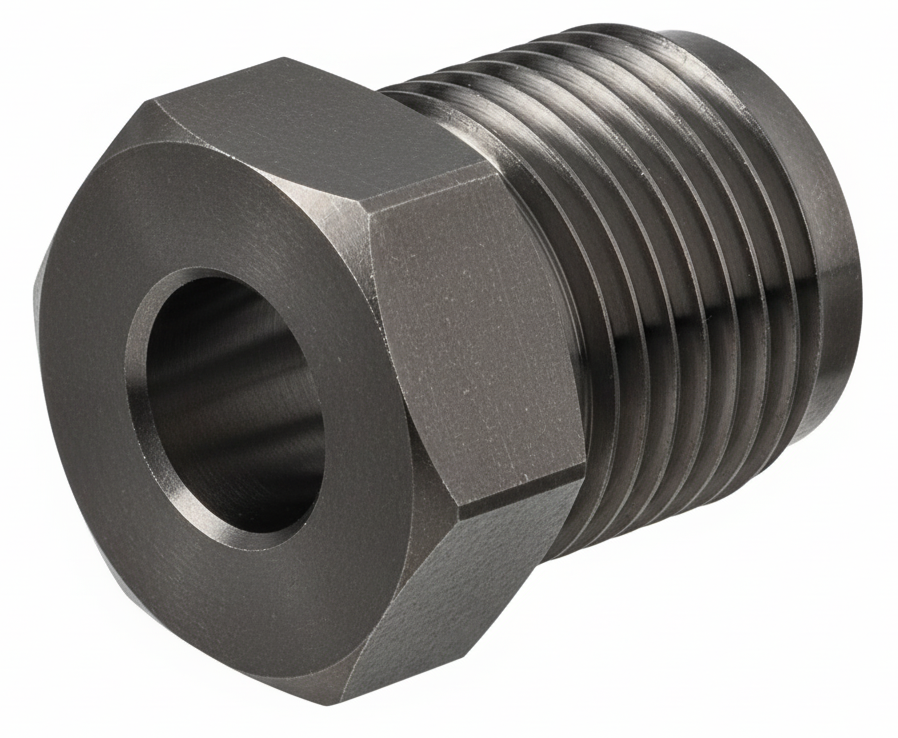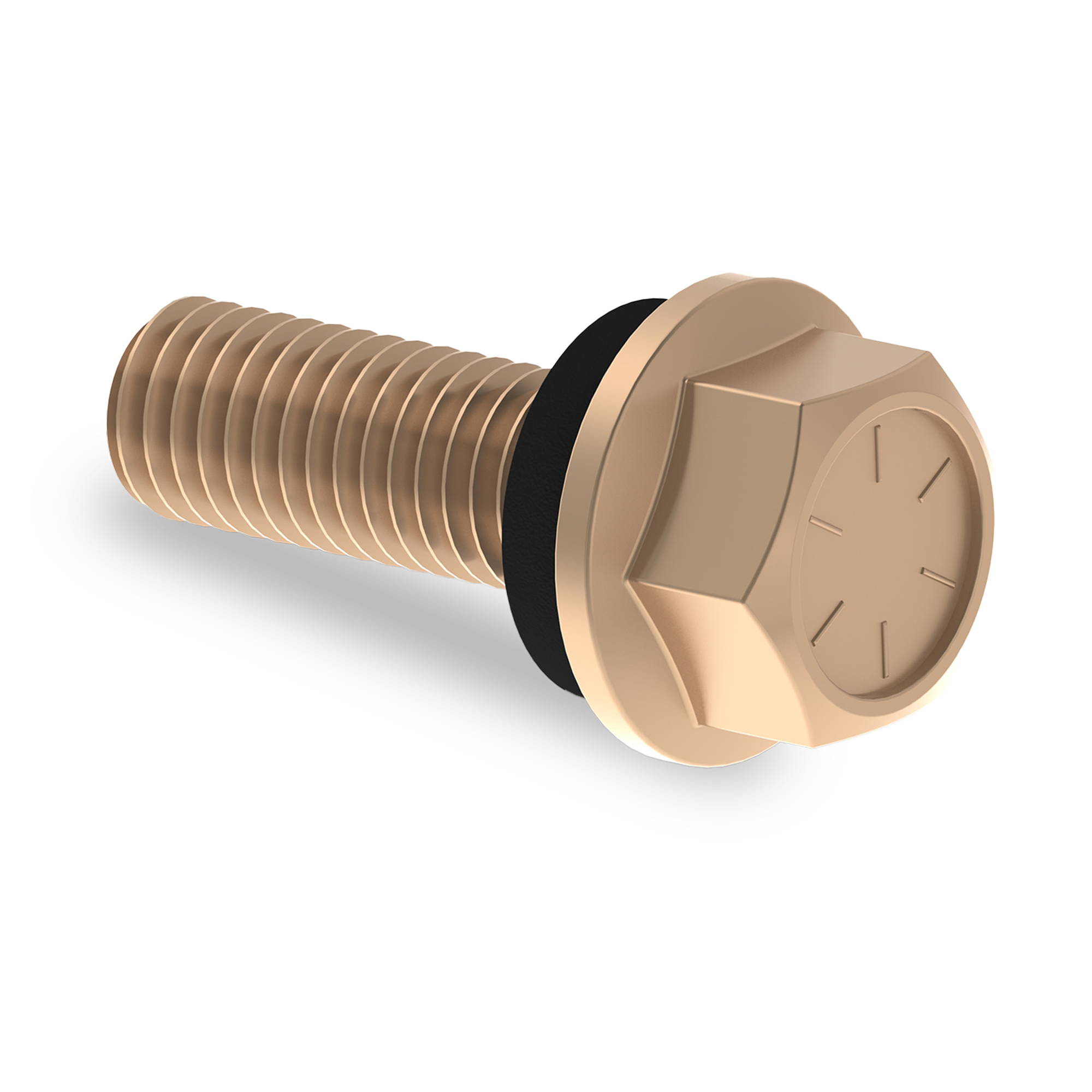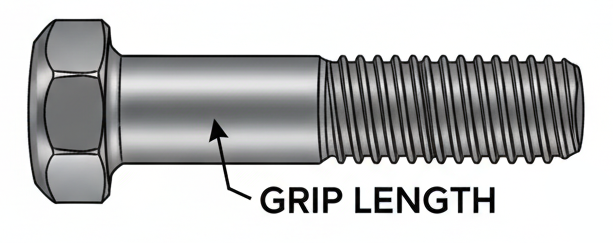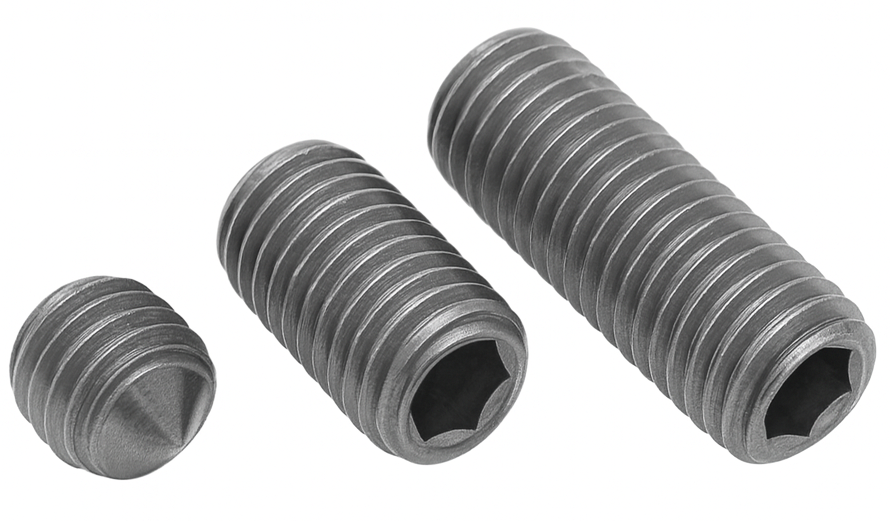Resources
Glossary
Galling
Galling is a type of wear and surface damage that occurs when two metal surfaces slide against each other under pressure, causing material to transfer from one surface to the other. It is sometimes referred to as a form of “cold welding” because the high friction and localized adhesion make the surfaces stick together and tear apart unevenly. This often results in rough, damaged threads, seized fasteners, or scratched and scored surfaces.
In fasteners, galling is most common with stainless steel, aluminum, and titanium bolts and nuts, because these metals have a tendency to form adhesive bonds when rubbed together. As torque is applied, microscopic high points (asperities) on the threads weld together under pressure. When the fastener continues to turn, these welded spots tear, pulling material from one surface to the other. This not only damages the fastener but can also cause it to seize, making removal extremely difficult.

Contributing factors to galling include high loads, lack of lubrication, soft or ductile metals, high-speed installation, and repeated tightening/loosening of the same fastener. The risk is especially high in applications with stainless steel fasteners used without lubrication.
Prevention methods include:
- Using anti-seize lubricants or specialized thread lubricants.
- Choosing fasteners with surface treatments or coatings (such as PTFE, zinc, or nitriding).
- Reducing installation speed and avoiding power tools that generate heat and friction.
- Mixing dissimilar metals (e.g., using a stainless steel bolt with a different nut alloy) to reduce adhesion.
- Using fasteners specifically designed with anti-galling properties.
Galvanic Corrosion
Galvanic corrosion is a form of electrochemical corrosion that occurs when two different metals are in electrical contact in the presence of an electrolyte, such as water that contains salts, acids, or other conductive impurities. This situation creates a galvanic cell, where one metal functions as the anode and the other as the cathode. The anode is the more active metal, meaning it has a greater tendency to give up electrons, and therefore it corrodes more quickly than it would on its own. The cathode, being the more noble metal, is protected from corrosion. A common example is seen when steel and copper are connected in a marine environment: the steel, acting as the anode, corrodes rapidly, while the copper, as the cathode, remains unharmed.

The severity of galvanic corrosion is influenced by several conditions. The greater the difference in electrochemical potential between the two metals, the faster corrosion will occur. The conductivity of the electrolyte also plays a major role, with saltwater being particularly aggressive in accelerating the process. Additionally, the relative size of the metals in contact affects the outcome; a small anode connected to a large cathode will corrode at a much faster rate due to the disproportionate distribution of current.
To prevent or reduce galvanic corrosion, engineers employ several strategies. Metals that are close to each other in the galvanic series are often chosen to minimize potential differences. Coatings, insulators, or paints can be applied to separate the metals electrically. Protective measures such as galvanization or the use of sacrificial anodes, like zinc on ship hulls, can redirect corrosion to a controlled, replaceable material. Designers may also consider the ratio of exposed metal areas to reduce the imbalance between anodic and cathodic surfaces.
In fasteners and construction, galvanic corrosion is especially important to address because it can compromise the integrity of joints and assemblies. A classic example is the use of stainless steel bolts in aluminum structures. Without proper insulation or coatings, the aluminum can corrode quickly in a moist environment, weakening the structure and leading to premature failure. This makes galvanic corrosion a critical factor in selecting and designing fastening systems for long-term durability.
Galvanizing Process
The galvanizing process for steel materials begins with caustic cleaning (degreasing), where steel parts are immersed in a hot alkaline solution, typically caustic soda. This step removes oils, grease, dirt, and organic contaminants from the surface. The parts are then rinsed in water to eliminate residues before moving to the next stage. After degreasing, the steel undergoes pickling (acid cleaning), which involves dipping the parts into a dilute acid bath—commonly hydrochloric acid (HCl) or sulfuric acid (H₂SO₄). This treatment removes mill scale, rust, and oxides that remain on the steel surface. Another water rinse follows to prevent acid carryover into later steps.
Once the steel is clean, it enters the fluxing stage. Here, the steel is dipped into a flux solution, typically zinc ammonium chloride (ZnCl₂ + NH₄Cl), which coats the surface. The flux prevents oxidation before immersion in molten zinc and helps ensure proper bonding between the steel and zinc during galvanizing. In some cases, a dry flux layer is applied and dried on the steel surface. When this method is used, a drying step may follow to reduce spattering when the steel is submerged into the molten zinc bath.

The core of the process is hot-dip galvanizing, where the steel is immersed in a bath of molten zinc maintained at about 450 °C (840 °F). At this temperature, the zinc metallurgically reacts with the steel surface, forming a series of zinc-iron alloy layers that are tightly bonded to the steel, topped with an outer layer of pure zinc. This metallurgical bond makes the coating exceptionally durable and resistant to peeling or flaking. After being withdrawn from the zinc bath, the parts undergo cooling and solidifying, either by air cooling or water quenching, which hardens the coating and prepares the galvanized product for handling.
Finally, the parts undergo inspection to verify the quality of the coating. This includes checking for coating thickness, adhesion, and uniform coverage. Inspections are carried out through visual examination, thickness measurements, and adherence testing to ensure the finished galvanized coating meets industry standards. The end result is a galvanized steel product with a protective zinc coating that provides both a physical barrier and sacrificial protection against corrosion, significantly extending the material’s service life in harsh environments.
Geomet®
A water-based zinc-aluminum flake coating system that provides high corrosion resistance without the use of hexavalent chromium. Commonly used on automotive and industrial fasteners, Geomet® coatings offer thin, uniform layers that resist heat, salt spray, and chemical exposure while maintaining consistent torque tension performance.
Gimlet Point
A tapered, sharp point on a screw designed to easily penetrate materials like wood or plastic without the need for a pilot hole. It helps start the screw smoothly and guides it into the material with less splitting or damage.
Gland Nut
A gland nut is a specialized fastening component designed to secure and compress a gland or packing in place, usually within mechanical or electrical systems that require reliable sealing. By tightening the gland nut, axial force is applied to compress the gland or packing material, which creates a seal that prevents the escape of fluids or gases, and in some cases protects against the ingress of dust, dirt, or moisture. Importantly, this type of seal allows for movement of a shaft, rod, or cable while maintaining system integrity.
In terms of design and construction, a gland nut is generally hexagonal or round with external flats so it can be tightened with a wrench. It has internal threads that allow it to screw onto a housing, stuffing box, or fitting. Inside the assembly, the gland nut presses against a gland follower or directly onto a packing material, such as graphite, PTFE, or elastomeric seals. In cable gland systems, the gland nut often squeezes a rubber or plastic grommet around the outer sheath of a cable, providing both sealing and strain relief. Gland nuts are commonly made from brass, stainless steel, or carbon steel for strength and durability, though engineered plastics are sometimes used for lightweight and corrosion-resistant applications.
The purpose and function of a gland nut are twofold: to create a controlled seal and to secure a component. In mechanical equipment such as pumps and valves, the gland nut compresses the packing material around a moving shaft or rod to prevent fluid leakage while still allowing motion. In electrical or instrumentation systems, the gland nut clamps a cable gland tightly around a cable, preventing it from being pulled out and maintaining protection against dust or water ingress. These features make gland nuts essential for both sealing and safety in demanding environments.
Common applications of gland nuts include pumps and valves, where they secure packing around shafts and valve stems; hydraulic and pneumatic cylinders, where they prevent fluid leakage along moving rods; and electrical cable glands, where they clamp and seal cables entering enclosures to provide ingress protection and strain relief. They are also widely used in marine, oil and gas, and other industrial sectors where protection against leakage and environmental exposure is critical.
The advantages of gland nuts are their simplicity and reliability. They provide an adjustable and cost-effective sealing solution compared to more complex systems like mechanical seals. They can often be reused or adjusted to compensate for packing wear, and they are available in a wide range of materials to suit corrosive, high-temperature, or otherwise demanding environments.
However, there are limitations to gland nuts. They require periodic maintenance, as packing materials compress and wear over time, which reduces their sealing effectiveness. The friction created between the packing and the moving shaft can cause wear, generate heat, and result in energy loss. Gland nuts are not ideal for extremely high-pressure or zero-leakage applications, where mechanical seals are better suited. Additionally, over-tightening can damage the packing or the shaft, leading to leaks or premature failure.

Grade
A term used to describe a fastener’s material properties and strength level. Used primarily for inch fasteners, grades are defined by standards organizations such as SAE, ASTM, ISO, or IFI, and help determine appropriate applications based on tensile strength, hardness, and overall performance. Higher grades typically indicate stronger, more durable fasteners.
Grade Markings
Symbols or numbers stamped on bolts, screws, nuts, or lock nuts that are used to easily identify the fastener’s strength level and material composition.
Grain Bin Bolts
Hex Flange Screws with EPDM Sealing Washers, also known as Grain Bin Bolts, are designed with a recessed flange under the head to fully conform to a rubber washer, creating a watertight and moisture-repellant seal. Earnest Machine's line of product comes preassembled with an EPDM washer, which performs well in extreme weather conditions, meaning the EPDM washer will not dry out or crack in the sun, and it will not become brittle in freezing temperatures.

Grip Length
Grip length is the total thickness of the materials being clamped by a bolt, screw, or stud, measured from under the fastener’s head (or nut, in the case of a stud) to the end of the unthreaded portion of the shank. It represents the combined thickness of the clamped parts, not including washers or nuts. The grip length is ideally equal to or slightly greater than the unthreaded shank, ensuring that shear loads are carried by the smooth shank rather than by the threads, which are weaker and more prone to fatigue.
It is different from overall fastener length, since it specifically refers to the section of the fastener engaged with the clamped materials. Grip length is especially important in applications like aerospace, automotive, and structural assemblies, where precision and durability are critical. For example, if two steel plates each 10 mm thick are bolted together, the grip length is 20 mm, regardless of the total bolt length.

Grub Screw
A grub screw, also known as a set screw, is a type of fastener specifically designed to secure one component against another without the need for a nut. Unlike conventional screws, a grub screw has no head—its entire body is threaded, and it is tightened or loosened using a recessed drive such as a hex socket (Allen), slotted, or Torx. This makes it ideal for applications where a flush or hidden fastening solution is required.
In terms of design and construction, grub screws are generally short, fully threaded cylindrical fasteners. Since they lack a head, they sit flush with or below the material’s surface when installed, creating a clean finish. The screw’s working end may be shaped in different styles—flat, cone, cup, dog, or oval—to suit how it grips the mating part. Materials such as alloy steel, stainless steel, and brass are commonly used, with heat treatments or coatings often added to enhance strength and corrosion resistance.
The main function of a grub screw is to lock two parts together by applying pressure at a single point. They are most frequently used to secure rotating components, such as gears, pulleys, or collars, onto shafts. By tightening the screw so that its tip presses directly against the shaft surface or into a prepared recess, the grub screw prevents movement, slippage, and misalignment, even under vibration or torque.
Grub screws have wide applications across industries. In machinery, they secure pulleys, gears, and collars. In electronics and instruments, they lock knobs or dials in place on rotary shafts. The automotive and aerospace industries use them in linkages, couplings, and compact rotating mechanisms where space is restricted. They also find use in furniture and fixtures, holding parts together discreetly without visible fastener heads.
The advantages of grub screws include their compact, flush fit with no protruding head, their ability to provide strong localized locking force, and the availability of various tip styles for different uses. They are also inexpensive and require only basic tools for installation. However, they come with limitations. Grub screws can damage shaft surfaces if not used with a flat or recessed spot, and they generally provide less holding strength than larger headed fasteners. They can also be difficult to remove if overtightened or if the drive recess becomes stripped. Additionally, effective use requires precise alignment and sufficient thread engagement.

